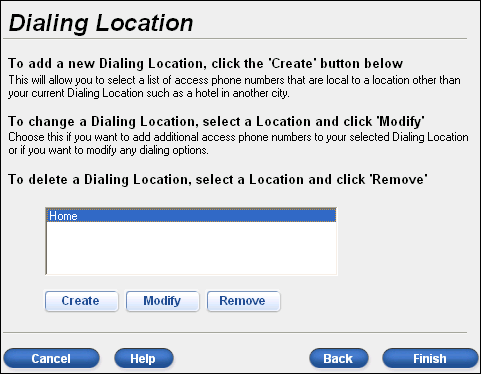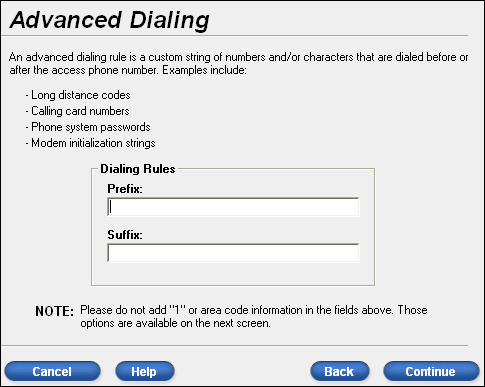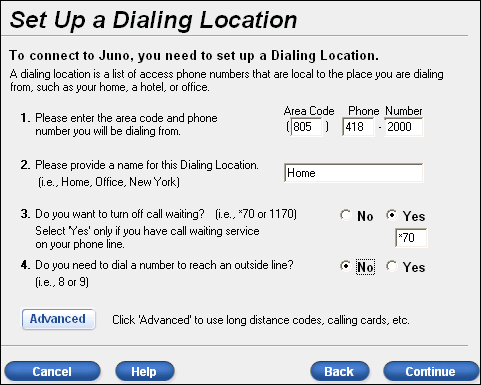Why Do I Get Disconnected? The most likely reason for your getting disconnected is due to line noise. Regular telephone lines were only designed to handle speeds up to 9600 bps, but compression technology can trick them into accommodating higher speeds. Unfortunately, this makes the higher speed connections (above 9600bps) more sensitive to line noise, and more prone to disconnection. There are several things you can do to deal with excessive line noise: - Avoid using a line splitter or other telephone device on the same wall jack. Try connecting your modem directly to a wall jack.
- Check your voice line for static. Pick up your phone and dial 1, then listen for pops, clicks, or static. If you notice line noise, call your telephone company to try to improve the line.
If you are still experiencing problems maintaining a stable connection with Juno try the following troubleshooting steps to help resolve the issue.
A. Try changing your access numbers Note: If you are subscribed to Juno's Toll-Free service please skip to step B. Change access numbers and verify your dialing preferences Sometimes a bad access number may prevent you from making a successful connection. Pay special attention to the number listed on your JTV screen during the connection process. If your connection fails after dialing the first access number, try removing that number from your selected list of access numbers and add other numbers that are local to you. Also, verify your dialing preferences. WARNING: THE USE OF SOME TELEPHONE ACCESS NUMBERS MAY RESULT IN LONG DISTANCE CHARGES. IN SELECTING YOUR ACCESS NUMBER(S), PLEASE NOTE THAT ALTHOUGH AN ACCESS NUMBER MAY BE IN YOUR AREA CODE OR LOCATED IN YOUR GENERAL GEOGRAPHIC REGION, IT MAY NOT NECESSARILY BE A LOCAL NUMBER FOR YOU. YOU MAY INCUR SUBSTANTIAL TELEPHONE CHARGES IF YOU CHOOSE ACCESS NUMBERS THAT ARE NOT COVERED BY YOUR LOCAL CALLING PLAN. WE URGE YOU TO CHECK WITH YOUR TELEPHONE COMPANY TO FIND OUT WHICH NUMBERS ARE LOCAL FOR YOU BEFORE USING A NUMBER FROM THIS LIST. To change access numbers and verify your dialing preferences: - Double-click the Juno icon.
- Click Settings on the Welcome screen and then click Locations.
- Select your location (e.g. Home) and click Modify.
- On the Set-Up a Dialing Location screen, verify the number of the telephone line connected to your computer. Do not turn off call waiting unless you have it enabled/active on your telephone line.
- Click Continue.
- The next screen allows you to select local access numbers. Check all the local numbers available to you. If you dial 10-digits to reach someone within the same area-code, check the Area Code box for each selected access number. If you dial 11-digits to reach someone within the same area-code, check the Dial 1 and Area Code boxes for each selected access number.
- Click Continue and then click Finish to proceed to the logon screen.
- Retry the Juno connection.

B. Add three commas to your custom suffix Try using three commas in your suffix Entering three commas after the phone number may solve connection problems. Try the following steps: - Double-click the Juno icon on your Desktop.
- Click Settings on the Welcome screen and then click Locations.
- On the Dialing Location screen, highlight your preferred location (i.e. Home) and click Modify.

- On the Set-Up a Dialing Location screen, click Advanced.
- On the Advanced Dialing screen, type three commas ,,, in the Suffix text box and click Continue.

- Click Continue, and click Continue again.
- On the Congratulations screen, confirm that the numbers you have chosen are displayed and that the three commas are included in the suffix.
- Click Finish and retry the Juno connection.
Placing 3 commas after the phone number will pause your computer's modem to wait for the signal (56K) coming from your access number's modem. If some brands of modems do not receive the signal immediately, they will automatically disconnect or look for the next connection speed (33.6k, 28.8k, etc). Although your access number's modem tries to connect at 56K, your computer's modem may try to connect at 33.6k or lower, possibly resulting in no connection at all. 
C. Do you have Call Waiting? Verify your Call Waiting Settings - Double-click the Juno icon on your Desktop.
- Click Settings on the Welcome screen and then click Locations.
- On the Dialing Location screen, highlight your preferred location (i.e. Home) and click Modify.

- On the Set-Up a Dialing Location screen, select whether to enable or disable Call Waiting by choosing the answer to question Do you want to turn off call waiting? and then click Continue.

- By default, the code for disabling your call waiting is set at *70. If you do not know the code, contact your phone company.
- Click Continue again and then click Finish to save your settings.
Note: If you do not have the call waiting service activated on your phone line, do not answer Yes to Do you want to turn off call waiting? 
D. Verify your modem settings Windows 98/ME Users: - Click the Windows Start button, point to Settings and select Control Panel.
- Double-click Modems and click the Properties button.
- Set the speed for your modem from the Maximum Speed, menu. For 14.4 modems use 19200, for 28.8 modems use 38400 and for 56k use 57600.
- Make sure Only connect at this speed is not checked
- Select the Connection tab.
- Under Call Preferences, ensure that the box marked Cancel the call if not connected within is unchecked. Some modems may not allow you to change the call preferences.
- Click OK then click Close to exit.
- Retry your Juno connection.
Windows XP/2000 Users: - Click the Windows Start button and select Control Panel.
Windows 2000 users: Click Settings and then Control Panel. - Double-click on the Phone and Modems icon.
Windows XP users: If you don't see this option, click Switch to Classic View after Step 1. - Select the Modems tab, highlight your modem and then click on the Properties button.
- Select the Modems tab, and set your modem speed from the Maximum Port Speed menu. For 14.4 modems use 19200, for 28.8 modems use 38400 and for 56k use 57600.
- Select the Advanced tab and click on Change Default Preferences.
- Under Call Preferences, change the value of the box marked Cancel the call if not connected within to 255. Some modems may not allow you to change the call preferences.
- Click OK three times to exit.
- Retry your Juno connection.
Windows Vista Users: - Click the Windows Start button and select Control Panel.
- Click on Hardware and Sound and then click on the Device Manager link.
- Double-click on Modems or click on the '+' sign next to Modems.
- Right-click on your modem in the list and click on Properties.
- Click the Modems tab, and set your modem speed from the Maximum Port Speed menu. For 14.4 modems use 19200, for 28.8 modems use 38400 and for 56k use 57600.
- Select the Advanced tab and click on Change Default Preferences.
- In General tab, under Call Preferences, change the value of the box marked Cancel the call if not connected within to 255. Some modems may not allow you to change the call preferences.
- Click OK and OK again to exit.
- Retry your Juno connection.

F. Are you experiencing timed disconnections? If you are a Free user and it seems you are disconnected every 20 - 30 minutes, you just need to interact with the JunoPort a little more. Any activity will do, such as clicking on ad, clicking on a search button, customize your settings, or even moving the JunoPort to another place on your screen. This periodic interaction with JunoPort will ensure that you are not disconnected from Juno. Access to Juno is free - thanks to the support of our advertisers. Because of their investment, they need assurance that someone is interacting with the JunoPort. The only way that we can ensure our advertisers of this interaction is if Juno members periodically interact with the JunoPort. We understand that notifying the JunoPort of your presence takes a little getting use to, but it is the most efficient and reliable way for us to keep our Internet services free. If you are being disconnected every 10 minutes, then you need to upgrade your Juno software. To upgrade to our latest version, click here. If you login to Juno and are immediately disconnected, you may be experiencing a modem issue. Try contacting your modem manufacturer for specific troubleshooting instructions. 
| |